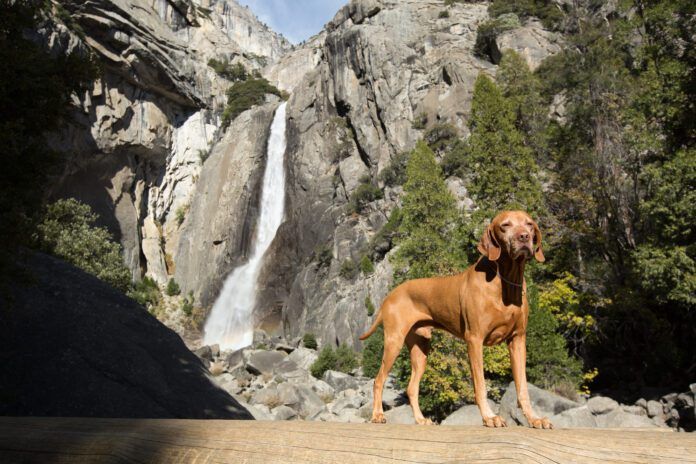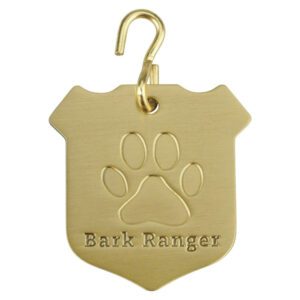
Are national parks dog-friendly? The answer depends on your definition of “dog-friendly.”
If you think dog-friendly includes letting your dog hike all of a park’s trails, run off-leash, and go everywhere with you and your family, then, no, national parks are not dog-friendly. If your well-behaved dog enjoys on-leash walks in designated areas with a maximum leash length of 6 feet, the answer is maybe. But an unequivocal “Yes!” answer depends on your ability to find a national park that is a good match to you, your dog, and your family.
Each national park has its own rules, but most prohibit dogs in public buildings, on trails, at swimming beaches, and on public transportation. Dogs cannot be left unattended on trails and in campgrounds, and they should never be left in a car in warm weather.
Service dogs (park rules mention guide dogs accompanying visually impaired persons and service dogs for hearing) are allowed in most areas, always on leash.
In national parks that allow hunting, dogs used in support of that activity are permitted as regulated by the park’s superintendent.
Which parks can I visit with my dog?
There are 423 national park sites in the United States and its territories, 63 of which have “National Park” in their names (there are also national battlefields, military parks, historical parks, lakeshores, monuments, and more). National park scenic trails, recreation areas, and historic locations make them popular vacation destinations, but whether you and your dog will enjoy the journey depends on your research and planning.
Dogs are allowed on some trails in only some national parks, such as Acadia, Grand Canyon, Cuyahoga Valley, Padre Island National Seashore, and Congaree. In most national parks, however, dogs are prohibited on hiking and scenic trails, and are welcome only on leash and only in campgrounds, parking lots, and other developed areas.
The website NPS.gov lists all the national parks, historic sites, national monuments, and other areas of interest. Search for parks in the states or areas you plan to visit, then study their basic information, calendars of events, current conditions, maps, alerts, and other details. Alerts identify roads or trails that are closed to visitors, hazardous weather warnings, smoke from wildfires, construction delays, and other current conditions.
Then go to this page, which features a map of the U.S. and all its national parks, with a link to each park’s rules concerning pets and where they are allowed.
National park dog rules
If all dogs were perfectly behaved, there wouldn’t be a need for restrictions, but dogs in national parks can:
- Chase or disturb large and small wild animals
- Negatively impact the behavior of native animals
- Damage a park’s ecosystem by digging up plants and harming fragile vegetation
- Stress, frighten, or injure people or other dogs
- Be injured by wildlife, other dogs, or accidents
In short, dogs can be a nuisance. But many dogs travel well and are safely under their handlers’ control in new environments, which makes them appropriate park visitors. The National Park Service rules about dogs were adopted to keep the parks safe while allowing visitors to enjoy their pets’ companionship, at least in some national parks.
Things to consider
As you research national parks, consider your dog’s personality, health, and exercise needs along with your own interests. Don’t forget to factor in the weather; extremes of heat and cold will affect your dog’s comfort and safety.
Does your dog travel well? Is he comfortable staying or sleeping in a crate? What time of year do you plan to visit? What environmental conditions (mosquitos, fleas, ticks, wildlife, snakes, cactus, heat, wind, rain, snow, paved roads, dirt trails, crowds, traffic) will affect you and your dog? How does your dog react to wild animals, other dogs, or people? For your dog’s safety, plan to keep a respectful distance from all three.
If you enjoy hiking, check to see which trails are open to dogs and study their descriptions to decide which match your dog’s capabilities. Most medium to large adult dogs in good condition can carry supplies weighing 10% to 12% of their body weight in a well-fitted dog pack (a maximum for conditioned canine athletes is about 25% of their body weight). To help your dog prepare for carrying a pack, start at home with small loads and build up gradually.
Will you stay for just a day or for several days? Will you be in a camper van? A tent? Will you camp inside the park, in an area adjacent to the park, or stay in a motel that allows pets? Is there a nearby boarding facility that can care for your dog if your inside-the-park plans don’t work out? Are there activities near but outside the park that you and your dog can enjoy together?
Your destination park’s website may have information about nearby boarding kennels, dog day care facilities, veterinarians, or other resources that can help with your planning.
Getting ready
If you decide that a trip to one or more national parks with your dog is a good idea, consider the following equipment:
- Water (bringing your own or filtering water is recommended because streams and lakes can carry waterborne pathogens such as giardia)
- Food, snacks, storage containers, and food bowls
- Pick-up bags and cleanup supplies
- An appropriate hands-free or hand-held leash, maximum length 6 feet
- A collar and/or harness
- An ID tag with up-to-date contact information and microchip details
- Contact information for your veterinarian, online veterinary information services, and veterinary clinics near the park that you’ll be visiting
- Appropriate canine attire such as a cooling vest or scarf in hot weather or an insulated dog jacket in cold weather
- Dog first-aid kit, grooming tool, drying towels, and paw protection
- Insect repellent or sunscreen, as needed
- Life vest or dog flotation device for lakes or river
- A comfortable dog bed
- For your car, extra towels or a canine seat cover
Do your research, come prepared, use common sense, and stay flexible. That way you, your dog, and your family will have the best possible park visit.
 Introduced as part of the Healthy People, Healthy Parks Initiative in 2018, this ranger-led program helps visitors enjoy positive experiences with their pets in unfamiliar environments. BARK stands for:
Introduced as part of the Healthy People, Healthy Parks Initiative in 2018, this ranger-led program helps visitors enjoy positive experiences with their pets in unfamiliar environments. BARK stands for:
Bag your pet’s waste
Always leash your pet
Respect wildlife
Know where you can go
The program teaches dog owners about the importance of following the BARK principles, and participating parks offer a short training program that includes a BARK Rangers swearing-in ceremony and BARK Ranger collar tags, stamps, wooden badges, or certificates. Some parks have customized tags for their location while others offer generic BARK Ranger tags.
Weirdly, there isn’t a list of the 60 BARK-participating parks on the NPS site, but there is one here.




